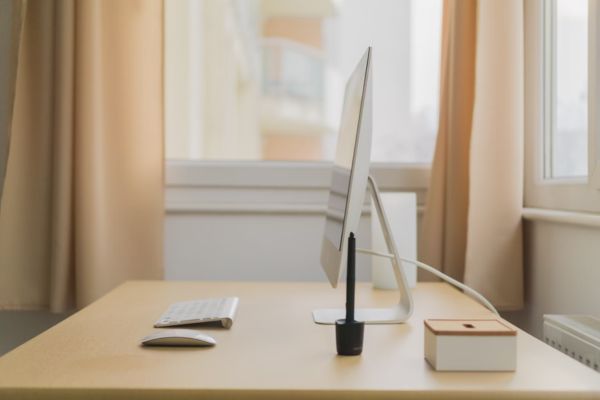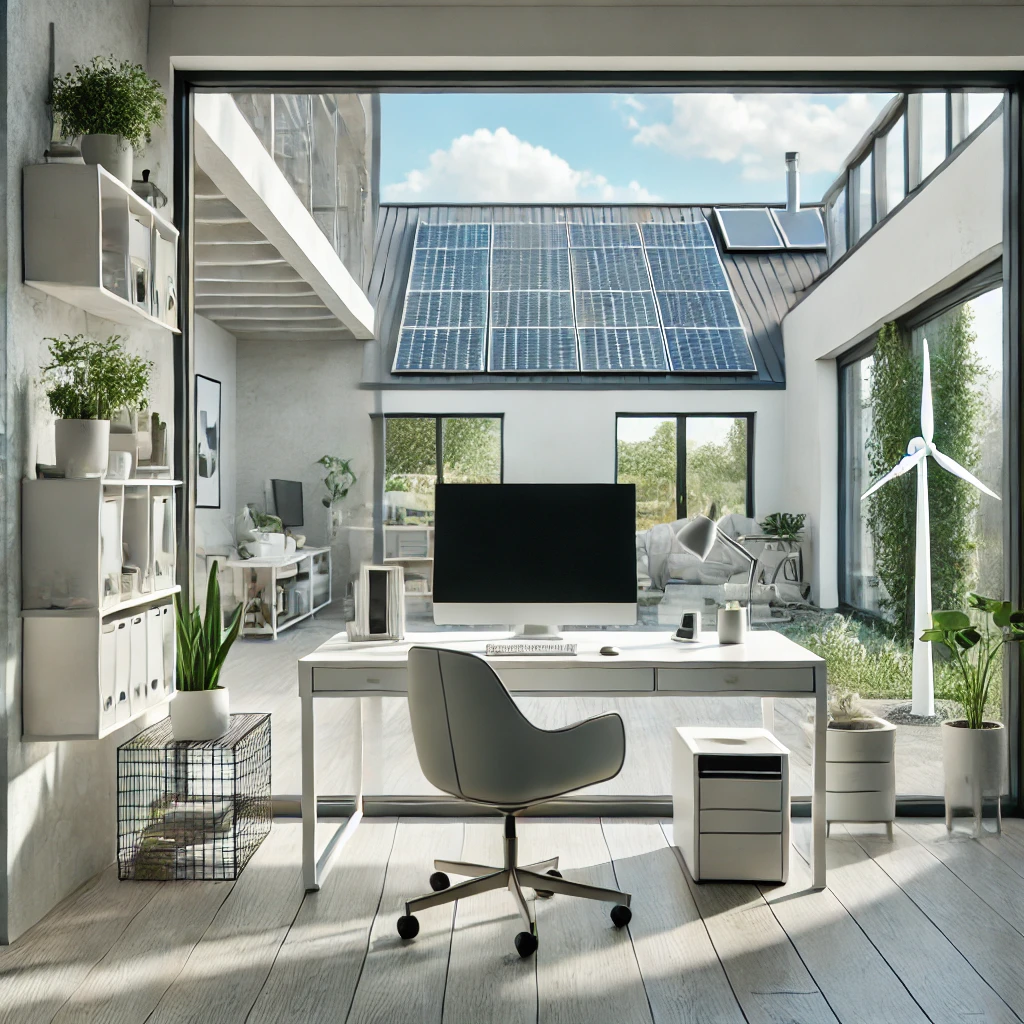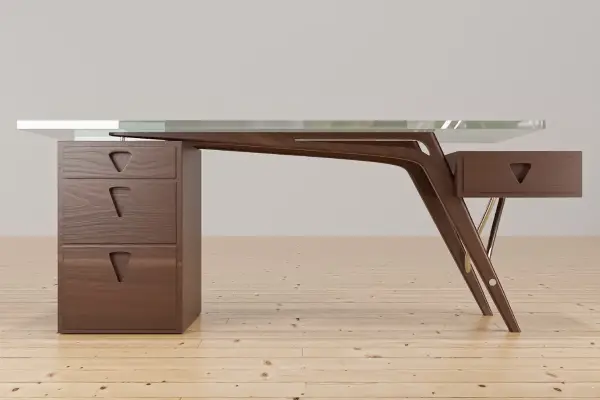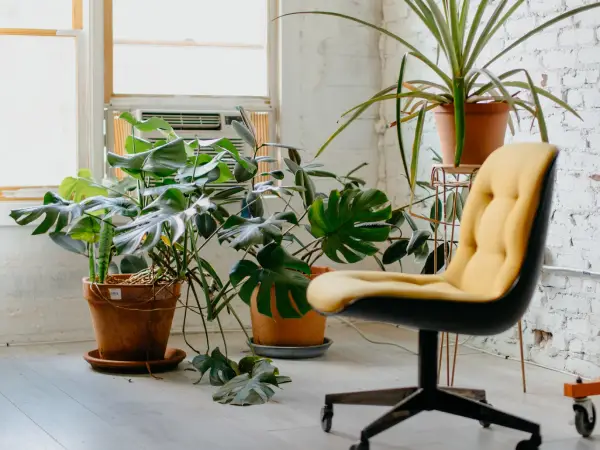In today’s fast-paced world, maintaining a tidy and minimalist desk is more important than ever. A clutter-free workspace not only enhances your productivity but also contributes to mental clarity and a sense of calm. With fewer distractions, you can focus better on the tasks at hand, leading to more efficient and effective work. This ultimate guide will walk you through the essential tips and strategies for creating and maintaining a minimalist desk setup that supports your goals and well-being.
Minimalism is not just about having fewer items; it’s about making intentional choices and creating an environment that fosters productivity and peace. A minimalist desk helps reduce stress and anxiety by eliminating unnecessary distractions and keeping your workspace organized. This streamlined approach allows you to concentrate on what’s truly important, leading to increased creativity and efficiency in your work.
In this guide, we will explore the principles of minimalism as they apply to desk organization, assess your current desk setup, and provide practical steps for decluttering and choosing the right storage solutions. We will also discuss how to organize your desk items based on their frequency of use and implement a maintenance routine to keep your workspace tidy over time. Finally, we’ll offer tips for personalizing your minimalist desk without compromising its simplicity and elegance.
Whether you’re just starting your minimalist journey or looking to refine your current setup, this guide will provide you with the tools and insights you need to create a tidy, efficient, and inspiring workspace. Let’s dive in and transform your desk into a haven of productivity and tranquility.
Understanding Minimalism in Desk Organization
Minimalism is more than just a trend; it’s a lifestyle choice that promotes simplicity, intentionality, and efficiency. When applied to desk organization, minimalism can transform your workspace into a clean, calm, and productive environment. Here’s an in-depth look at the principles and benefits of a minimalist desk setup.
Definition and Principles of Minimalism
Minimalism in desk organization focuses on eliminating unnecessary items and distractions, leaving only what is essential and functional. The key principles of minimalism include:
Intentionality: Every item on your desk should serve a specific purpose and contribute to your productivity.
Simplicity: Keep your desk setup as straightforward and uncomplicated as possible.
Clarity: A clear, uncluttered workspace promotes mental clarity and focus.
Functionality: Prioritize functionality over aesthetics, but strive to balance both for a pleasant working environment.
Mindfulness: Be mindful of what you bring into your workspace, ensuring it aligns with your goals and needs.
Benefits of a Minimalist Desk Setup
A minimalist desk offers numerous advantages that can significantly enhance your work experience. Here are some of the key benefits:
Increased Focus and Productivity
A cluttered desk can be distracting, pulling your attention away from your tasks. By keeping only essential items within reach, a minimalist desk minimizes distractions and helps you stay focused. With fewer visual stimuli, your brain can concentrate better, leading to increased productivity and efficiency.
Reduced Stress and Anxiety
Clutter is often linked to higher stress levels. A tidy, organized desk creates a sense of order and control, which can reduce stress and anxiety. Knowing exactly where everything is and having a clean workspace can make you feel more at ease and ready to tackle your work.
Enhanced Creativity and Efficiency
A minimalist desk setup encourages creativity by providing a clear space for new ideas to flow. Without the distraction of unnecessary items, you can think more freely and creatively. Additionally, an organized desk improves efficiency as you spend less time searching for items and more time on productive tasks.
By understanding and embracing these principles and benefits, you can create a minimalist desk that not only looks good but also enhances your overall work performance. In the next section, we will assess your current desk setup and identify steps to begin your minimalist journey.
Assessing Your Current Desk Setup
Before diving into the process of creating a minimalist desk, it’s essential to take a step back and assess your current setup. Understanding what you have and how it impacts your work is the first step towards achieving a clutter-free and efficient workspace. Here’s how to effectively evaluate your desk:
Taking Inventory of Your Desk Items
Start by taking a thorough inventory of everything on your desk. This includes:
Office Supplies: Pens, pencils, notebooks, staplers, etc.
Technology: Computer, keyboard, mouse, chargers, external drives.
Personal Items: Photos, plants, decorations.
Documents: Papers, folders, books.
Miscellaneous: Any other items that have found their way onto your desk.
Write down a list of these items or take a photo to get a visual sense of the current state of your desk.
Identifying Essential vs. Non-Essential Items
Once you have a clear inventory, it’s time to categorize each item based on its necessity:
Essential Items: These are items that you use daily or frequently and are crucial for your work. Examples include your computer, essential office supplies, and key documents.
Non-Essential Items: These are items that are rarely used or do not contribute directly to your productivity. Examples include old papers, excess office supplies, and redundant tech gadgets.
Ask yourself these questions for each item:
Do I use this item regularly?
Does it directly contribute to my work efficiency or productivity?
Would my work suffer without this item?
Understanding the Impact of Desk Clutter on Work Efficiency
Recognize how desk clutter affects your work:
Visual Distractions: A cluttered desk can divert your attention, making it harder to focus on your tasks.
Wasted Time: Searching for misplaced items can waste valuable time and disrupt your workflow.
Mental Clutter: Physical clutter can lead to mental clutter, making it difficult to think clearly and prioritize tasks.
Reduced Productivity: A messy workspace can create a sense of chaos, which can hinder your productivity and overall work performance.
By thoroughly assessing your current desk setup, you gain a clear understanding of what changes need to be made to transition to a minimalist workspace. This assessment will serve as the foundation for the decluttering process, which we will explore in the next section.
Decluttering Your Desk
Once you have assessed your current desk setup and identified essential and non-essential items, it’s time to start decluttering. Decluttering is a crucial step in creating a minimalist workspace that promotes productivity and mental clarity. Here’s how to effectively declutter your desk:
Steps to Declutter Effectively
Start with a Clean Slate
Begin by completely clearing your desk. Remove everything from the surface, drawers, and any surrounding areas. This allows you to start with a blank canvas and gives you a better perspective on what you truly need.
Clean Your Desk: Take the opportunity to thoroughly clean your desk. Wipe down surfaces, vacuum any dust, and ensure the area is pristine before you start organizing.
Categorize and Prioritize Items
With your desk cleared, categorize all your items into groups. Common categories might include office supplies, technology, documents, and personal items.
Determine Necessity: For each category, determine which items are essential and which are non-essential. Essential items are those you use frequently and are crucial for your work.
Create a Priority List: Make a list of must-have items that need to return to your desk. This list should be as concise as possible to maintain a minimalist setup.
Implement the “One In, One Out” Rule
To maintain a clutter-free desk in the long term, adopt the “one in, one out” rule. For every new item you bring into your workspace, remove an old one. This helps prevent future clutter and keeps your desk organized.
Consistent Practice: Make this rule a consistent practice. Whether it’s a new office gadget or a decorative item, always consider what can be removed to make space for the new addition.
Tips for Letting Go of Non-Essential Items
Letting go of items can be challenging, especially if you feel attached to them. Here are some tips to help you release non-essential items:
Be Objective: Evaluate each item objectively. If it doesn’t serve a clear purpose or hasn’t been used in the last few months, it’s likely non-essential.
Donate or Recycle: Consider donating or recycling items that are still in good condition but no longer needed. This not only clears your desk but also benefits others and the environment.
Digitize Documents: Reduce paper clutter by digitizing documents. Scan important papers and store them digitally, freeing up physical space on your desk.
Limit Personal Items: While it’s nice to have personal touches, limit them to a few meaningful items. This ensures your workspace remains professional and uncluttered.
By following these steps and strategies, you can effectively declutter your desk, paving the way for a minimalist and efficient workspace. In the next section, we will explore how to choose the right desk and storage solutions to further enhance your minimalist setup.
Choosing the Right Desk and Storage Solutions
After decluttering your desk, the next step is to choose the right desk and storage solutions that align with minimalist principles. Selecting functional and aesthetically pleasing furniture and organizational tools can significantly enhance your workspace’s efficiency and appearance.
Types of Desks Suitable for a Minimalist Workspace
Simple and Clean Design
Opt for a desk with a simple, clean design. Avoid desks with intricate details or excessive compartments, as these can create visual clutter. A sleek, modern desk with a flat surface and minimal features is ideal for a minimalist workspace.
Ample Surface Area
Choose a desk with ample surface area to accommodate your essential items without feeling cramped. A spacious desk allows for a clean and organized layout, providing enough room for your computer, a few office supplies, and personal touches.
Built-in Storage Options
Desks with built-in storage options, such as drawers or shelves, can help keep your workspace tidy. However, ensure these storage solutions are used wisely and not as a catch-all for clutter.
Storage Solutions for a Tidy Desk
Desk Organizers
Invest in desk organizers to keep your essential items within reach and neatly arranged. Pen holders, trays, and small containers can help organize your office supplies and prevent them from scattering across your desk.
Drawer Dividers
If your desk has drawers, use dividers to separate and categorize items. Drawer dividers make it easier to find what you need and keep everything in its place, reducing the chances of clutter building up.
Shelving Units
Consider adding shelving units above or beside your desk. Shelves provide additional storage space for books, documents, and decorative items. Keep these shelves organized and avoid overcrowding them to maintain a minimalist look.
Cable Management Tools
Loose cables can create visual clutter and make your workspace look messy. Use cable management tools such as clips, sleeves, or cable boxes to keep cords organized and out of sight. This not only improves the aesthetics of your desk but also prevents tangling and makes cleaning easier.
Criteria for Selecting Appropriate Desk and Storage Solutions
Functionality
Prioritize functionality when choosing desk and storage solutions. Each piece should serve a specific purpose and contribute to an organized and efficient workspace. Avoid items that are purely decorative or serve no practical function.
Aesthetic Alignment with Minimalist Principles
Ensure that your desk and storage solutions align with minimalist aesthetics. Opt for items with clean lines, neutral colors, and simple designs. Avoid overly ornate or bulky pieces that can detract from the minimalist look.
By carefully selecting the right desk and storage solutions, you can create a workspace that is both functional and visually appealing. In the next section, we will discuss how to organize your desk items based on their frequency of use, further enhancing your minimalist setup.
Organizing Desk Items by Frequency of Use
Once you have chosen the right desk and storage solutions, it’s time to organize your desk items based on how often you use them. This approach ensures that your most important tools are always within easy reach, while less frequently used items are stored away but still accessible when needed. Here’s how to effectively organize your desk items by frequency of use:
Daily Use Items
Keep Within Easy Reach
Items you use daily should be easily accessible to avoid interrupting your workflow. These items include:
Computer and Accessories: Your computer, keyboard, mouse, and any other essential tech accessories.
Writing Tools: Pens, pencils, and a notepad for quick notes.
Planner or Calendar: If you use a physical planner or calendar, keep it within arm’s reach to manage your schedule efficiently.
Frequently Used Office Supplies: Items like staplers, sticky notes, and paperclips should be kept in an organizer on your desk.
Examples and Suggestions
Pen Holder: Use a pen holder to keep your writing tools organized and easily accessible.
Desk Tray: A small desk tray can hold frequently used supplies like sticky notes and paperclips.
Monitor Stand with Storage: Consider a monitor stand with built-in storage compartments for your keyboard and other accessories.
Weekly Use Items
Store Nearby but Out of the Way
Items you use on a weekly basis should be stored nearby but not clutter your immediate workspace. These items include:
Reference Materials: Books, manuals, or documents that you refer to regularly but don’t need every day.
Additional Office Supplies: Backup pens, notepads, and other supplies that you don’t use daily but need to have on hand.
Examples and Suggestions
Desk Drawer: Store weekly use items in a desk drawer organized with dividers to keep everything in its place.
Shelf Storage: Place reference materials on a shelf above or beside your desk for easy access without taking up desk space.
Storage Boxes: Use labeled storage boxes to keep additional office supplies organized and out of sight until needed.
Occasional Use Items
Store in Less Accessible Areas
Items that you use occasionally can be stored in less accessible areas to keep your primary workspace clear. These items include:
Archived Documents: Papers and files that you need to keep but don’t reference often.
Seldom Used Equipment: Tech gadgets or office tools that you use infrequently.
Examples and Suggestions
File Cabinets: Store archived documents in a file cabinet organized with labeled folders for easy retrieval when needed.
Under-Desk Storage: Use under-desk storage solutions, like rolling carts or bins, to keep seldom used items out of the way but still accessible.
High Shelves: Place rarely used items on higher shelves to free up space within easy reach for more frequently used items.
By organizing your desk items based on their frequency of use, you can maintain a tidy and efficient workspace. This system ensures that your most important tools are always within reach while minimizing clutter from less frequently used items. In the next section, we will discuss implementing a maintenance routine to keep your desk organized over time.
Implementing a Maintenance Routine
Creating a tidy, minimalist desk is just the first step; maintaining it requires regular upkeep. By establishing a maintenance routine, you can ensure your workspace remains clutter-free and efficient. Here are some practical tips for implementing a maintenance routine:
Daily Habits for Maintaining Organization
End-of-Day Cleanup Routine
Developing a quick end-of-day cleanup routine can help keep your desk organized and ready for the next day. Spend just a few minutes each evening tidying up your workspace.
Clear Your Desk: Put away any items that are out of place. Store office supplies, papers, and personal items in their designated spots.
Tidy Up Cables: Ensure all cables are neatly arranged and not tangled.
Wipe Down Surfaces: Quickly wipe down your desk to keep it clean and free of dust.
By ending each day with a clean desk, you’ll start the next day with a fresh, organized workspace.
Regularly Reassessing Desk Items
To maintain a minimalist desk, regularly reassess the items you keep on it. This helps prevent clutter from accumulating over time.
Weekly and Monthly Maintenance Checks
Weekly Check: At the end of each week, review the items on your desk. Remove anything that is no longer needed or can be stored elsewhere.
Monthly Decluttering: Conduct a more thorough decluttering session once a month. Evaluate all the items on and around your desk, ensuring everything has a purpose and place.
Reviewing and Adjusting Organization Systems
As your work habits and needs evolve, so should your organization systems. Periodically review your storage solutions and desk layout to ensure they still meet your needs.
Adjust Storage Solutions: If you find certain items are frequently out of place, consider adjusting your storage solutions to make them more accessible.
Optimize Layout: Rearrange your desk layout if you notice inefficiencies or clutter. Ensure that frequently used items are within easy reach and seldom used items are stored away.
Ensuring Consistency with Minimalist Principles
Maintaining a minimalist desk requires a commitment to the principles of minimalism. Regularly remind yourself of these principles to stay on track.
Be Intentional: Continuously evaluate the necessity of each item on your desk. Only keep items that serve a specific purpose.
Practice Simplicity: Avoid overcomplicating your organization systems. Keep your setup as simple and straightforward as possible.
Embrace Clarity: Maintain a clear and uncluttered workspace to promote mental clarity and focus.
By implementing these daily habits and regular maintenance routines, you can sustain a tidy, minimalist desk that supports your productivity and well-being. In the next section, we will explore how to personalize your minimalist desk without compromising its simplicity.
Personalizing Your Minimalist Desk
A minimalist desk doesn’t have to be devoid of personality. Personal touches can make your workspace more enjoyable and inspiring without compromising its simplicity and functionality. Here are some tips on how to personalize your minimalist desk:
Adding Personal Touches Without Creating Clutter
Personalizing your desk is all about balance. Choose items that reflect your personality and bring joy, but ensure they don’t contribute to clutter.
Limit Decorations: Select a few meaningful decorations that enhance your workspace. Avoid overcrowding your desk with too many items.
Functional Personal Items: Opt for personal items that also serve a functional purpose, such as a stylish pen holder or a beautifully designed notebook.
Rotating Decorations: Consider rotating your personal items periodically. This keeps your desk fresh and allows you to enjoy different items without cluttering your space.
Choosing Meaningful and Functional Items
Incorporate items that have personal significance and utility. This adds a personal touch while maintaining the minimalist aesthetic.
Photos and Art: Display a small framed photo or piece of art that inspires you. Keep it simple and choose frames that match your minimalist decor.
Inspirational Quotes: A neatly framed quote or a small desk plaque with an inspiring message can add a personal touch and motivation.
Functional Decor: Select decor items that serve a dual purpose, such as a decorative clock, a desk lamp, or a stylish organizer.
Incorporating Aesthetics into Supply Organization
Even everyday office supplies can contribute to the aesthetics of your desk. Choose items that align with your minimalist style.
Coordinated Supplies: Use office supplies that match or complement your desk’s color scheme. This creates a cohesive and visually pleasing look.
Stylish Storage Solutions: Opt for sleek and modern storage solutions, such as metal or wooden organizers, that add a touch of elegance to your desk.
Elegant Design Choices: Select items with clean lines and simple designs. Avoid overly ornate or bulky pieces that can disrupt the minimalist flow.
Simple and Elegant Design Choices
A minimalist desk can still be stylish. Choose simple and elegant design elements that enhance the overall look of your workspace.
Plants and Natural Elements: Adding a small plant or natural elements like a stone paperweight can bring a refreshing touch to your desk. Plants not only add aesthetic appeal but also improve air quality and create a calming atmosphere.
Neutral Colors: Stick to a neutral color palette for your desk and accessories. This promotes a sense of calm and order, which is central to minimalist design.
Minimalist Accessories: Choose desk accessories that are both functional and aesthetically pleasing. Items like a sleek desk lamp, a minimalistic calendar, or a modern mouse pad can enhance the look of your desk without adding clutter.
By adding personal touches thoughtfully, you can create a minimalist desk that is both functional and uniquely yours. Personalization doesn’t have to mean clutter; with the right choices, your desk can be a harmonious blend of simplicity and personality. In the next section, we will discuss common pitfalls to avoid in maintaining your minimalist desk.
Common Pitfalls to Avoid
Maintaining a tidy, minimalist desk can be challenging, especially if you’re not aware of common pitfalls that can lead to clutter and inefficiency. By recognizing and avoiding these mistakes, you can ensure your workspace remains organized and functional. Here are some common pitfalls to avoid:
Over-Accumulating Supplies
Just-in-Case Items
It’s easy to accumulate items that you think you might need someday, but this often leads to unnecessary clutter.
Limit Extras: Resist the urge to stockpile supplies. Only keep what you regularly use and can realistically fit in your designated storage areas.
Evaluate Necessity: Regularly assess the necessity of each item. If you haven’t used it in the past few months, it’s likely not essential.
Unnecessary Duplicates
Having multiple versions of the same item can quickly clutter your desk.
Consolidate Supplies: Keep only one or two of each essential item. For example, you don’t need five pens on your desk; one or two should suffice.
Avoid Duplicates: Be mindful when purchasing new supplies. Ensure you’re not duplicating items you already have.
Overcomplicating Storage Solutions
Complex Organization Systems
While it’s important to have a place for everything, overly complex systems can be hard to maintain and counterproductive.
Simplicity is Key: Choose simple, straightforward storage solutions that are easy to use and maintain.
Functional Design: Opt for storage options that make it easy to find and access your items. Avoid systems that require too many steps or are difficult to manage.
Too Many Containers
Using too many containers can create visual clutter and make it harder to find things.
Use Wisely: Only use containers where necessary. Avoid over-segmenting your storage, which can lead to confusion and inefficiency.
Clear Containers: Consider using clear containers so you can easily see what’s inside without having to open each one.
Neglecting Regular Maintenance
Infrequent Decluttering
Even the best organization systems require regular maintenance to stay effective.
Routine Checks: Schedule regular decluttering sessions, such as weekly or monthly reviews, to keep your desk tidy.
Stay Consistent: Make decluttering a consistent part of your routine. Regularly assess and remove items that are no longer needed.
Ignoring the “One In, One Out” Rule
Failing to follow the “one in, one out” rule can lead to gradual accumulation of items and clutter.
Stick to the Rule: For every new item you bring into your workspace, remove an old one. This helps maintain a balance and prevents clutter from building up over time.
Be Disciplined: Apply this rule to all types of items, from office supplies to personal decorations.
By avoiding these common pitfalls, you can maintain a clean, organized, and efficient minimalist desk. Recognizing these challenges and implementing strategies to counteract them will help you sustain the benefits of a tidy workspace. In the next section, we will conclude with a recap of essential tips and strategies for maintaining a minimalist desk.
Conclusion
Creating and maintaining a tidy, minimalist desk is a journey toward a more organized and productive workspace. By following the strategies outlined in this guide, you can achieve a clutter-free environment that promotes focus, creativity, and overall well-being.
Recap of Essential Tips and Strategies
Declutter Effectively: Start with a clean slate, categorize items, and implement the “one in, one out” rule to minimize clutter.
Choose the Right Desk and Storage: Opt for a simple desk design with ample surface area and functional storage solutions that align with minimalist principles.
Organize by Frequency of Use: Keep daily use items within easy reach, store weekly use items nearby but out of the way, and reserve less accessible areas for occasional use items.
Implement a Maintenance Routine: Develop daily habits like an end-of-day cleanup, regularly reassess desk items, and adjust organization systems to maintain order.
Personalize Thoughtfully: Add personal touches that enhance your workspace without overwhelming it, focusing on meaningful and functional items.
Avoid Common Pitfalls: Steer clear of over-accumulating supplies, overcomplicating storage solutions, and neglecting regular maintenance.
Encouragement to Start and Maintain
Starting the journey to a minimalist desk may seem daunting, but the benefits—increased productivity, reduced stress, and a clear mind—are well worth the effort. Remember, maintaining a minimalist desk is an ongoing process that requires consistency and mindfulness. Each small step you take toward organization and simplicity contributes to a more efficient and enjoyable work environment.
Final Thoughts on the Benefits of a Minimalist Desk
A minimalist desk isn’t just about aesthetics; it’s about creating a workspace that supports your goals and inspires creativity. By prioritizing what truly matters and eliminating distractions, you create space for clarity and focus. Embrace the principles of minimalism in your workspace, and you’ll find yourself more productive, less stressed, and better equipped to achieve your professional and personal goals.
Implement these tips, stay committed to your minimalist mindset, and enjoy the benefits of a tidy and efficient workspace. Here’s to a clutter-free desk and a clearer path to success!






